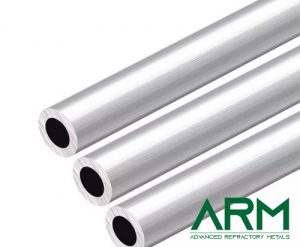Zirconium alloys are indispensable materials in industries such as nuclear energy, chemical processing, and aerospace. Their unique properties, including exceptional corrosion resistance, low neutron absorption, and high mechanical strength, make them vital for demanding applications. Among the most widely used zirconium alloys are Zircaloy-2, Zircaloy-4, and Zr-2.5Nb, each with distinct characteristics and applications.

1 Zircaloy-2
Zircaloy-2 is composed of approximately 98% zirconium, with small additions of tin (~1.5%), iron (~0.15%), chromium (~0.10%), and nickel (~0.05%). It is renowned for its high resistance to corrosion in water and steam environments, a property essential for its primary use in nuclear reactors.
- Properties:
Zircaloy-2 offers excellent corrosion resistance with a corrosion rate of less than 0.1 mg/dm²/day in boiling water. Its mechanical strength is moderate, with a tensile strength of 485 MPa at room temperature and a yield strength of approximately 379 MPa. The material’s neutron absorption cross-section is very low, at 0.18 barns, making it ideal for nuclear applications. - Applications:
Zircaloy-2 is commonly used for cladding nuclear fuel rods, particularly in boiling water reactors (BWRs). Its corrosion resistance also finds use in chemical plants for piping and containers exposed to aggressive environments.
Further reading: Zirconium Alloys 101
2 Zircaloy-4
Zircaloy-4 is a refined version of Zircaloy-2, designed to improve performance in high-temperature water environments by excluding nickel. Its composition includes zirconium (~98%), tin (~1.5%), iron (~0.2%), and chromium (~0.1%). The removal of nickel enhances its corrosion resistance, particularly in high-temperature pressurized water reactors (PWRs).
- Properties:
Zircaloy-4 exhibits superior corrosion resistance compared to Zircaloy-2, with a corrosion rate of less than 0.05 mg/dm²/day in PWR conditions. Its tensile strength is slightly higher, at 520 MPa, and it maintains a yield strength of approximately 415 MPa. The material is also resistant to hydrogen pickup, with a hydrogen absorption rate reduced by 20% compared to Zircaloy-2, increasing its durability under prolonged exposure to reactor conditions. - Applications:
The alloy is the preferred choice for fuel cladding in PWRs, where it withstands high-pressure and high-temperature water without significant degradation. It is also used in structural components of reactors operating in demanding thermal and mechanical environments.
3 Zr-2.5Nb
Zr-2.5Nb, consisting of 97.5% zirconium and 2.5% niobium, is engineered for applications requiring higher strength and resistance to hydrogen embrittlement. This alloy’s unique composition gives it a significant edge in mechanical performance while maintaining excellent corrosion resistance.
- Properties:
Zr-2.5Nb has a tensile strength of approximately 650 MPa and a yield strength of 540 MPa, surpassing both Zircaloy-2 and Zircaloy-4. Its corrosion resistance is exceptional, with a corrosion rate of less than 0.03 mg/dm²/day in water and steam environments. The alloy’s hydrogen embrittlement resistance is among the best in zirconium alloys, making it highly reliable for extended use in high-stress conditions. - Applications:
The alloy is predominantly used in CANDU (Canada Deuterium Uranium) reactor pressure tubes, where its high strength supports heavy loads and its hydrogen resistance ensures long-term integrity. It is also used in aerospace components exposed to extreme thermal and mechanical stresses.
Comparative Overview of Key Properties
| Property | Zircaloy-2 | Zircaloy-4 | Zr-2.5Nb |
| Corrosion Rate (mg/dm²/day) | ≤ 0.1 | ≤ 0.05 | ≤ 0.03 |
| Tensile Strength (MPa) | ~485 | ~520 | ~650 |
| Yield Strength (MPa) | ~379 | ~415 | ~540 |
| Hydrogen Absorption | Moderate | Low | Very Low |
| Neutron Absorption (barns) | 0.18 | 0.18 | 0.20 |
Advantages and Challenges
Zircaloy-2 and Zircaloy-4 are essential for their compatibility with water reactors, providing low neutron absorption and excellent corrosion resistance. However, they are less suitable for high-strength requirements, which is where Zr-2.5Nb excels. The higher tensile and yield strengths of Zr-2.5Nb make it ideal for pressure tubes, but the alloy’s slightly higher neutron absorption limits its use in applications where neutron economy is critical.
One common challenge across zirconium alloys is their cost, driven by the complexities of extraction and fabrication. Additionally, the alloys require specialized handling to maintain their properties during machining and welding.
Future Perspectives
Advancements in zirconium alloy development aim to further improve hydrogen resistance, corrosion resistance, and mechanical properties while reducing costs. Research into new zirconium-niobium-tin alloys and advanced coatings could expand their applications in next-generation reactors and extreme industrial environments. The alloys are also being explored for renewable energy systems, where their corrosion resistance can improve the efficiency and longevity of equipment.
Conclusion
Zircaloy-2, Zircaloy-4, and Zr-2.5Nb come with corrosion resistance, strength, and thermal stability. These zirconium alloys are indispensable for nuclear reactors, chemical plants, and aerospace applications. As technology advances, they will continue to play a pivotal role in high-performance and high-reliability systems. For more zirconium products, please check Advanced Refractory Metals (ARM).
